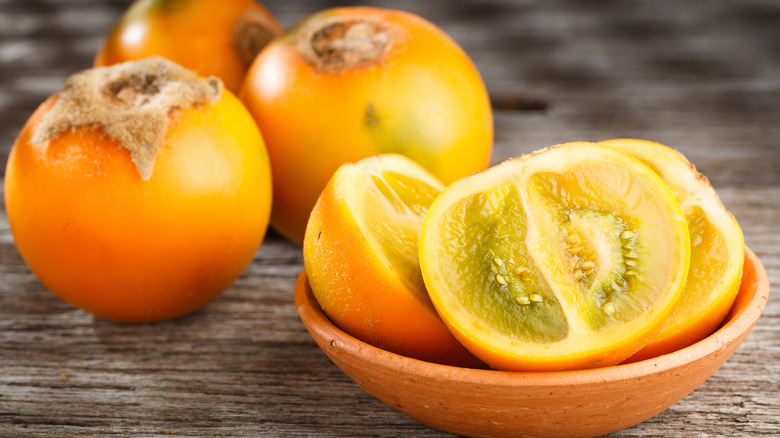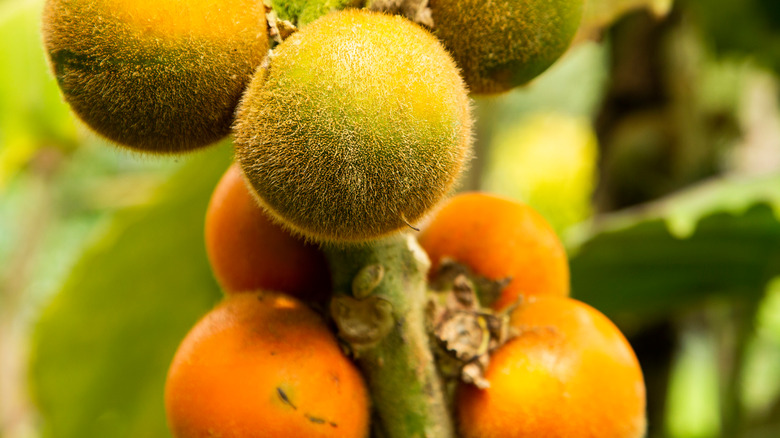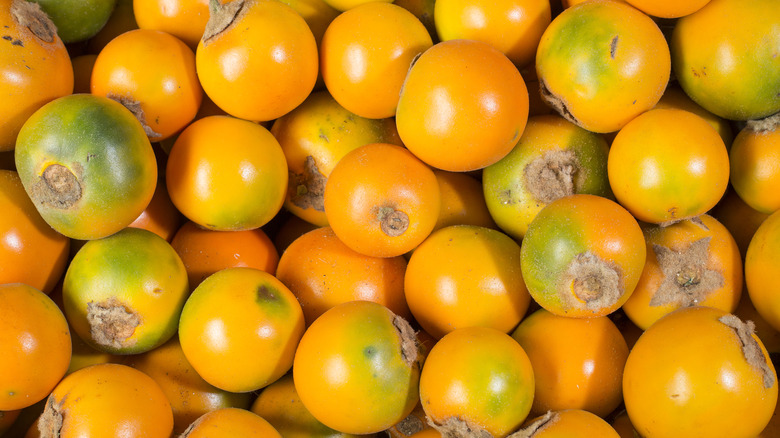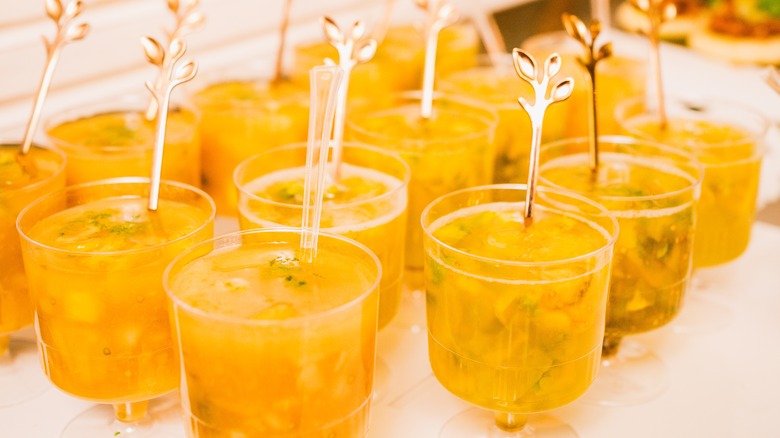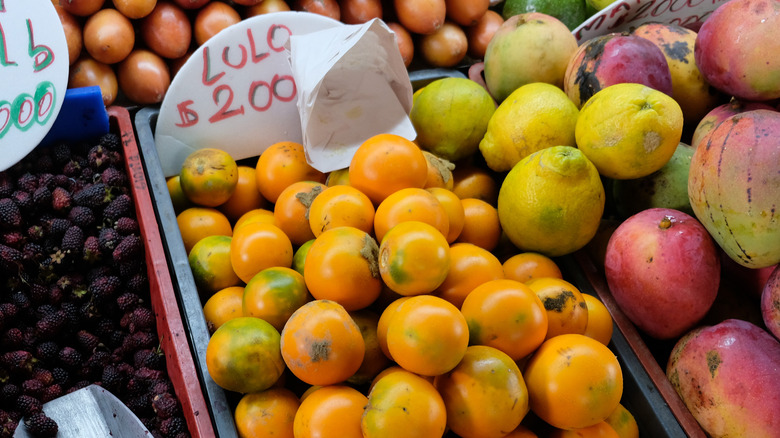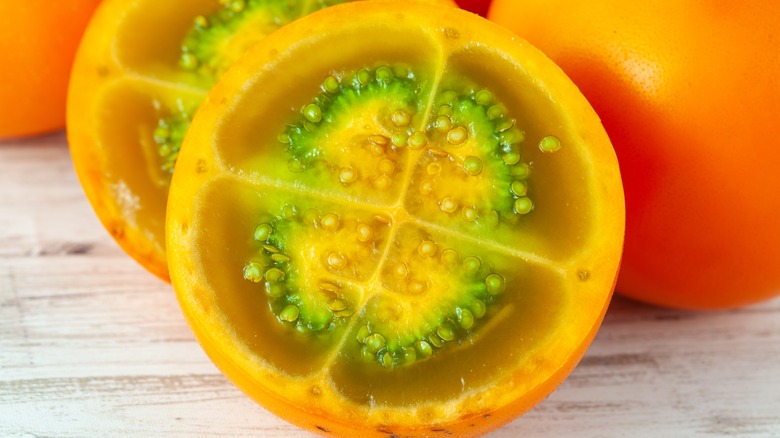Colombia's Lulo Is A Must-Try For All The Citrus Fruit Lovers
South America offers a diverse range of flavorful fruits, with camu camu, açaí, and passionfruit, as just three examples. While some are becoming popular in the U.S., there are many that are still absent from the limelight here.
One example is the tangy, vibrant delight that is the lulo (Solanum quitoense). Especially popular in Colombia, this tropical fruit, also known as a naranjilla (meaning little orange), delivers a tart hit. Its flavor is complex, with a definite citrus taste, and also notes of pineapple, and even rhubarb. The edible pulp is contained in a tomato-like vessel, but the thick skin isn't eaten. The insides are scooped out and used in various ways.
Unfortunately, the delicate nature of the lulo has prevented widespread distribution when fresh. It is reasonably easy to get hold of the processed fruit, however. And even when turned into frozen pulp, or preserved in syrup, lulos bring a bright note to a variety of dishes. Let's dive into the details of this juicy tropical fruit.
What are lulos?
Although lulos may resemble persimmons and taste citrussy, they're actually part of the nightshade family, making them a close relative of tomatoes. Recorded usage traces back to at least the 17th century, and it's likely that native consumption predates even further. These fruits hail from the low Andes in Peru, Colombia, and Ecuador, with later expansion to Panama and Costa Rica. Today, they're still produced in these countries, with most grown in Ecuador and Colombia.
The fruit grows abundantly on tall shrubs that reach nearly 10 feet in height, with a single plant yielding up to 150 lulos annually. They must be picked when ripe, a stage when they're most delicate and easily damaged.
Additionally, the lulo season is limited — they're only picked from December until March in the southern hemisphere. Factoring in susceptibility to disease and insects, and a short shelf-life, the fruit are difficult to transport, which means they're mostly sold not far from where they're farmed. This is why they're relatively obscure in the U.S. and most other countries. But it's worth searching them out because lulos are incredibly delicious.
What do lulos taste like?
Lulos taste tart and tropical. Their most prominent flavor notes are citrus, with a strong similarity to lime, and a resemblance to kiwi. There are also hints of pineapple, underlaid with a complexity that some say is akin to the astringency of rhubarb. The fruit's flavor varies in intensity depending on the climate and other factors relating to where it's grown. However, most generally, lulo is known for its highly acidic character, which some describe as abrasive. As a result, most people add a sprinkling of sugar or other sweetener before eating.
Only the pulp of lulo fruit is edible. The exterior skin is not only tough but oftentimes covered in small irritating hairs. The yellow-green interior flesh has a thick, gelatinous texture. Divided across four sections, the fruit's structure is reminiscent of a beefsteak tomato and has a similar explosive juiciness. There's also an abundance of small seeds inside, which lend a crunchy character that can add interest to drinks and dishes in which the fruit is used.
How to prepare food and drinks with lulos
Lulo can be eaten raw with a spoon, but is more often a component of a dish or drink. Meshing well with other fruits, it's especially popular as a juice. In Colombia, it's prepared into a drink called lulada, which combines the fruit with lime, sugar, and ice. In neighboring Peru and Ecuador, it's also crafted into a corn-based beverage known as champús, alongside other tropical fruits, cinnamon, and cloves. Such ease of integration makes it popular in other juice mixes, and cocktails, too — adding a shot of rum, tequila, or vodka to a lulada is one easy option.
The lulo's tropical flavor melds well in desserts, too. It offers a bright note in frozen sweets like ice cream and popsicles or can be used as a filling in baked goods. Lulo's taste shines in custards, like Colombian esponjados de lulo, a set dessert made with lulo, cream, honey, and eggs. The fruit also works well in jams, preserves, and even hot sauces. Due to its short shelf life, the lulo is frequently processed to preserve its flavor. A few spoonfuls of frozen lulo pulp can add a delightful tang to everything from a yogurt bowl to even a soup.
Where to buy lulos
As we've mentioned, lulos can be hard to come by outside of their native growth region. A few growers exist in Florida, with small-scale sales of the fruit. Although hard to grow, they are slowly increasing in presence among specialist tropical fruit vendors. Otherwise, it's best to sample fresh lulos where they are grown, in Central America and the northern regions of South America.
However, it is feasible to obtain the fruit's bright flavor in processed form, too. Frozen pulp can be bought in packs online. Lulo puree is also available in bottles, which is useful for making tasty tropical juices at home. Lulos preserved in syrup can also be found in the U.S., lending easier applicability to desserts.
For those in an appropriate climate, it's possible to try and grow lulos. You can purchase lulo seeds online. The plant needs a warm environment and is better planted in partial shade than in bright sunlight. It may need overwintering indoors, however. If you're an adventurous home grower, it's worth giving a lulo plant a go.
Nutritional information of lulos
In addition to its tangy taste, this zingy fruit packs some beneficial nutritional content. Just 100 grams (roughly a single fruit) of lulo offers 18% of the daily recommended amount of vitamin K, which aids in blood vessel functions and inhibits osteoporosis. Lulos' other significant nutrition component is vitamin A, which helps with white blood cell production, as well as bone strength. Plus, a single fruit contains about 12% of your daily requirement of dietary fiber, which promotes digestion. It offers a smattering of other benefits, too. Lulos contain a small quantity of vitamin C, and minerals including calcium, zinc, and magnesium.
Although beneficial on its own, combining the fruit with others will achieve the largest medley of nutrients. When added to a vitamin C-rich kale and kiwi-based smoothie, the little lulo can help give you a substantial dose of daily vitamin requirements. So if you're fortunate enough to acquire a batch, throw them into your next smoothie (or even cocktail) — their bright flavor will still shine.
